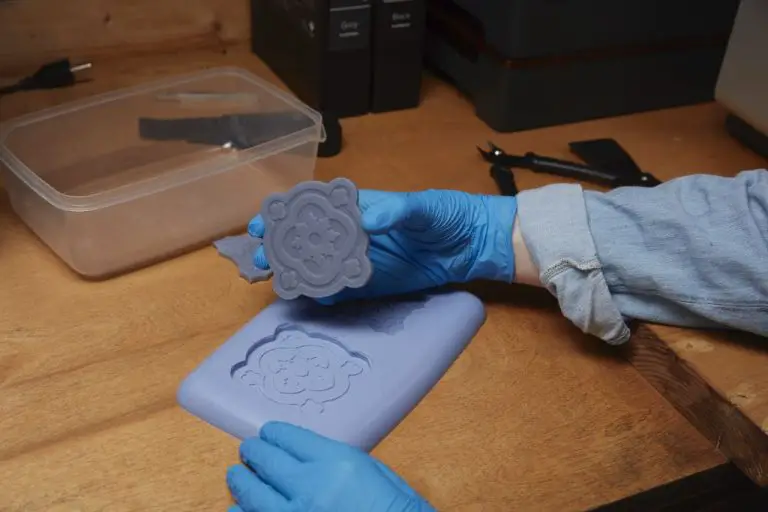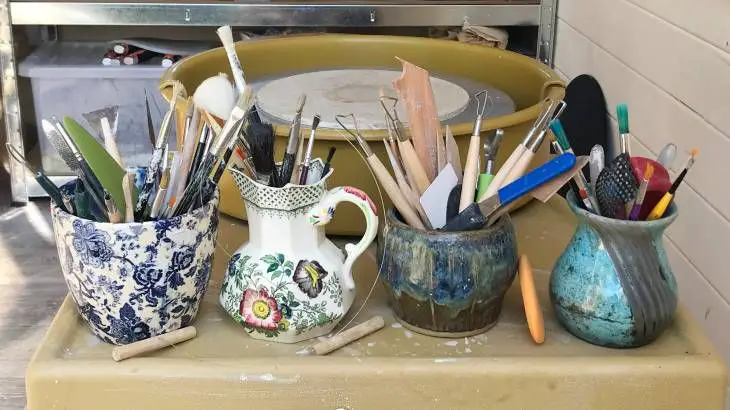What Are 3 Common Tools Used When Working With Clay?
Modeling Tools
Wire loop tools, ribs, metal scrapers, and wooden modeling tools help shape, smooth, and sculpt clay. Wire loop tools consist of variously shaped metal loops on wooden handles that are used to refine curves and scrape away excess clay. Ribs refer to thin, flexible metal strips that can compress and smooth clay. Metal scrapers have flat, blunt edges for slicing, cutting, and scraping clay surfaces. Wooden modeling tools include paddles, wedges, loops, and points for imprinting patterns and textures.
These fundamental hand tools for clay give artists precise control over the form and surface of their creations. Using an assortment of modeling tools allows sculpting fine details, making additions or subtractions, and achieving desired textures. They are essential for shaping pottery, sculptural works, tiles, relief panels, and other clay artworks. With practice and experience, artists learn which specific modeling tools work best for their desired effects in the clay medium.
Cutting Tools
Some essential cutting tools for working with clay include clay cutters, wire, dental tools, and X-Acto knives. These tools are used to precisely cut, trim, and slice clay to achieve the desired shapes and forms.
Clay cutters come in a variety of shapes and sizes, from small circular cutters to create uniform shapes to specialty cutters that produce unique textures and patterns. Using a clay cutter is an easy way to quickly cut out consistent forms.
Wire tools allow for both cutting and slicing clay. A tight wire can slice through clay smoothly, while a loose wire can create rough or ragged edges. Wires are useful for making clean cuts and separating built-up forms.
Dental tools like scalpels and picks can make very fine and delicate cuts in clay, which is useful for detailed sculpting and carving work. Their thin, tapered blades provide excellent control and precision.
X-Acto and other craft knives cut, trim, and shape clay with their sharp, thin blades. These knives allow artists to make both broad cuts as well as fine detail work. The replaceable blades can be swapped out when dull for continued cutting ability.
Having an assortment of cutting tools on hand gives clay artists the flexibility to cut their clay freely and achieve different effects from clean slices to rough tearing. They are essential tools for controlling and perfecting the form.
Texturing Tools
Texturing tools are used to add visual interest and realism to clay sculptures and pottery. They allow the artist to replicate the look of various textures and surfaces in the clay.
Some common texturing tools for clay work include:
- Sponges – Natural and synthetic sponges can be used to create porous, irregular textures. The clay can be pressed against the sponge, or the sponge can be pressed into the clay.
- Silicone tips – Special silicone sculpting tips come in a variety of shapes like waves, scales, and leaves. They are pressed into the clay to quickly add realistic textures.
- Sculpting loops – These metal loops can imprint lines, ridges, and patterns when pressed into the clay.
- Toothbrushes – Stiff toothbrush bristles can create nice brush stroke effects. The clay can be scratched, stippled, or brushed to add texture.
![]()
Texturing clay by hand with tools takes some skill, but adds an organic, handcrafted look. It allows the artist to enhance realism and make their work visually interesting.
Measuring Tools
Accurate measurements are crucial when working with clay. Measuring tools like rulers, calipers, templates, and cutting guides help measure proportions, thickness, height, and width when planning and executing clay projects. Rulers and tape measures are essential for measuring length and diameter. Calipers with pointed tips can measure thickness and depth on curved surfaces. Custom templates made from wood, plastic or metal act as guides for cutting uniform shapes and sizes. Clay cutting wires mounted in special guides assist with slicing clay into precise widths or lengths.
Having the right measuring tools on hand gives more control over clay dimensions and achieves consistency across pieces. Take time to measure twice and cut once to avoid wasting clay. Check measurements periodically to ensure the desired size and shape is maintained throughout the sculpting process. Precision measurements lead to professional results.
Finishing Tools
Some important finishing tools for working with clay include:
- Spray bottles – Spray bottles are used to mist water on clay surfaces to keep them from drying out while working. The fine mist helps keep clay moist and workable. Source
- Chamois – Chamois are soft leather cloths used to burnish and smooth clay surfaces. Rubbing a chamois over clay compresses and seals the surface. Source
- Scoring tools – Scoring tools like knifes, ribs, and loop tools are used to scratch grooved lines in clay surfaces to help with adhesion when attaching two pieces of clay. The grooves give slip and glazes something to hold onto. Source
Having the right finishing tools allows potters to properly smooth, seal, and join clay surfaces when handbuilding or throwing on the wheel. Spray bottles, chamois, and scoring tools are essential for prepping clay pieces before firing.
Rolling Tools
Rolling tools are used to flatten, shape, and thin clay. The three main types of rolling tools are rolling pins, slab rollers, and clay extruders.
Rolling pins are cylindrical tools made of wood, acrylic, or metal that are rolled across the surface of the clay to flatten it into a sheet or slab. They come in various sizes and allow control over the thickness of the clay. Rolling pins are a versatile, inexpensive tool good for rolling out clay for handbuilding and slab construction techniques.
Slab rollers are tabletop devices with two or more rollers that clay is fed through to flatten it into thin, even sheets. The space between the rollers can be adjusted to control the slab thickness. Slab rollers quickly roll uniform slabs for projects with flat bases like tiles or plates. They are ideal when you need to roll a lot of clay to an exact thickness.
Clay extruders force clay through a shaped die to create a continuous strip of clay. Dies come in various shapes like circles, squares, and rectangles. Extruders are great for making long coils for coil building and evenly shaped slab construction. They allow efficient, consistent production of clay components.
Molding Tools
Molds, stamps, and formers are essential molding tools used when working with clay. Molds help shape clay into consistent forms and sizes. They are useful for repeatedly making identical clay pieces, like tiles, cups, or bowls. Plaster, resin, silicone, and bisqueware are common mold materials.
Clay artists use molds in several ways. Pouring slip into a mold creates an instant clay form when the excess liquid is poured out. Pressing soft clay into an open mold shapes the clay to the inside surface. Molds with relief designs can imprint textures onto clay. Two-piece molds clamp together around clay to form both the interior and exterior surfaces.
Stamps make instant impressions in clay, similar to rubber stamps. From simple geometric patterns to detailed scenes, stamps quickly decorate clay surfaces. Stamping in clay’s leather-hard stage creates the crispest impressions.
Formers are solid shapes that support clay while it dries, keeping the desired form. Plaster and bisqueware formers work well. Clay shrinks slightly when drying, so formers are usually a bit larger than the finished piece.
For efficiency and consistency, molds, stamps, and formers are invaluable molding tools for clay artists. With a vast range available, clay workers can find the right models, stamps, and formers to shape, texture, and support their projects.
Carving Tools
Carving tools are used to add detail, texture, and dimension to clay pieces. Some common clay carving tools include:
Loop tools have a variety of shaped wire or wooden loops on the end that can be used to carve grooves and indentations into leather-hard clay. They allow for precision and control when carving fine details and textures. Loop tools come in many shapes like round, tear drop, heart, oval, square and more to provide different effects (The Pottery Network).
Ribs are usually made of flexible metal or wood and have a rounded edge. They are rubbed across the surface of clay to both smooth and compress it. Ribs can create grooved textures when pressed into soft clay and are useful for smoothing seams and shaping Potter’s rings (Ceramic Arts Network).
Clay gouges have a U or V shaped end and are used to remove clay and carve lines and channels. They come in varying widths. Narrow gouges carve finer lines while wider ones can quickly remove larger sections of clay.
Dental tools have fine picks and scalers that allow intricate carved effects like scales or feathers to be etched into the clay surface.
Joining Tools
When working with clay, joining multiple pieces together smoothly can be challenging. Thankfully, there are some useful joining tools and techniques that make the process easier:
Making slip is one common method for joining clay pieces. Slip is a mixture of water and clay that acts as an adhesive between sections. To create slip, simply mix together some of the clay and water, adjusting the consistency as needed. Apply a thin layer of slip to the surfaces to be joined, then firmly press them together (Source).
Using a scoring tool or knife to roughen the surfaces before joining can also help create better adhesion. Score parallel lines into both pieces of clay, then add slip and press together (Source). The grooves help the slip grip.
There are also specialty clay fasteners like texture makers, needle tools, or clay cutters that can puncture holes to thread a piece of clay through and fasten sections together. An epoxy glue like Apoxie Sculpt is another good option for a strong bond.
Miscellaneous Tools
Needle tools, clay shavers, and smoothers have specialized uses. Needle tools can add texture and details to clay surfaces. They come in various diameters for different effects. Clay shavers help remove excess clay and smooth curved surfaces. Smooth rounded tools are useful for gently blending seams and softening edges.
Other miscellaneous but handy clay tools include:
– Clay cutters for cutting slabs of uniform thickness
– Rolling pins for rolling out clay slabs
– Texture sheets/rollers to imprint patterns
– Cutting wires for slicing clay cleanly
– Hole cutters for piercing clay
– Ribbon tools to thin and elongate clay
Having an assortment of miscellaneous specialized tools on hand gives more options when working with clay.


